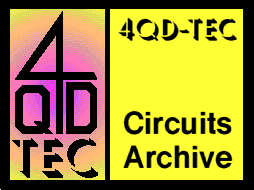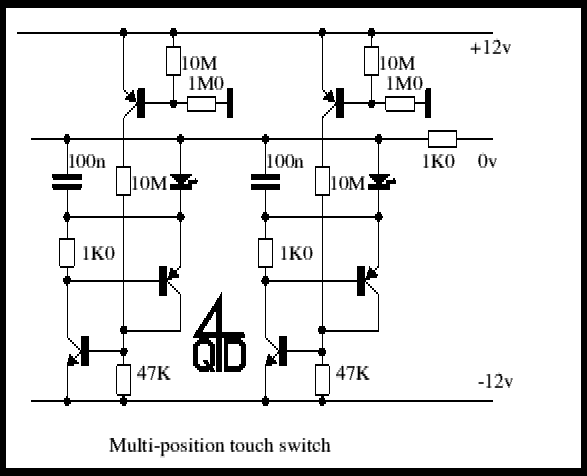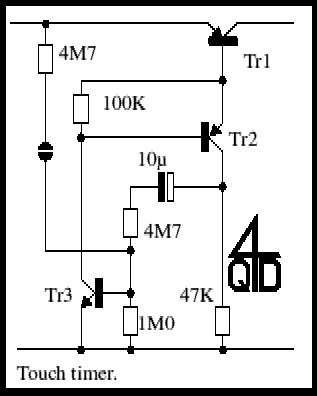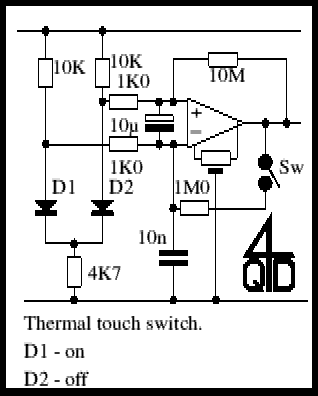

|
4QD-TEC
|
|
Touch operated switches are an attractive project for DIY electronics but they are not so common in commercial products. The reason for this is that, although there are many different ways of implementing a touch switch (leakage, hum pickup, capacitance, albedo) all of them rely on body parameters which vary a lot with the person's body, age and environment so that a circuit which gives reliable operation with one development engineer may cause problems in use with, for instance, old folks living in arid areas. Nevertheless touch switches can give excellent results.
There is another point to be considered: it is very obvious to use a high impedance input IC for a touch switch. The obvious choice is CMOS. But CMOS is static sensitive and a touch switch that can be damaged by static will not prove reliable: static is pretty unpredictable as a person's ability to form a static charge also depends on the person's body, age and environment. However it also depends on the clothes they wear, their shoes and the floor covering!
In the '70s quite a few TVs and other products used touch switching and several ICs were available. These are not so common nowadays, partially for the above reasons and partially because miniaturization has reduced the panel areas available to implement touch switches. A touch switch needs quite a large area for reliable operation, unlike a push-button. However I note that Farnell list a new touch controlled dimmer IC - the LS7232.
At the date of putting up this page it is not finished: there are a lot of circuits and it will take time to draw out and describe them all. So, to give you a taste, the page is here anyway.
This one is the equivalent to those banks of push buttons where you push any switch and it releases one already pushed in.

I've only shown two stages but you can have 5 - or ten if you wish. Consider the state with the first stage on. Current flows from the 0v line through the 1K resistor, the LED and the bottom two transistors. The centre line will then be at about -10v.
Now touch input 2. The top transistor will pass current into the bottom transistor: the two bottom transistors will turn each other hard and suddenly on. But the 100n capacitor has no voltage across it so it takes a pulse of current as it charges up. Instantaneously he centre line drops to -12v and the LED which was on extinguishes. Since the current that was flowing through this LED also flowed through the first pair, these turn off. The first 'button' has been released.
Quite a nice, simple circuit for a multi button touch switch.
This is a timer or power switch. Touch the contacts and the switch turns on. After a preset delay it turns off again. Its output is from a pass transistor so you can use it to operate another circuit during its timeout period.

Touching the contacts causes a current to flow through the 4M7 into Tr3's base turning it on. Its collector current turns on Tr2. The 10µ capacitor is not charged, so it charges up, holding Tr3 on. Meanwhile Tr2's emitter current turns on Tr1, applying power to the load.
While the 10µ is charging (determined by the 4M7 in series with it) the circuit stays on but when the 10µ is sufficiently charged the current through it is too small to hold on Tr3 and the whole circuit turns off.
You can alter the timing by changing the 4M7 or the 10µ.
This is an unusual touch switch that relies on the fact that the voltage drop in a diode is a function of its temperature. Warming the diode up reduces its voltage drop by about 2mV per degree centigrade (at room temperature).

To set up the circuit, close the switch and adjust the offset (using the preset) to zero. Now open the switch. The two inputs are at the same voltage (as offset by the zero adjust) so the output state in indeterminate but is whether it is high or low the 10M resistor gives positive feedback which holds it in the set state. Consider the circuit with its output high: the positive input is held a little high - a stable state - until D2 gets warmed. The positive input falls a little so the circuit changes state and is held low as the diode temperatures equalise. Now is D1 gets warmed the negative input voltage falls - and the circuit flips high again.
I don't recall where I got this circuit from but it's quite an unusual one. The main problem is the time it takes for a finger to warm up the diode. Thermal response time always causes delays!
| 4QD Sites: |